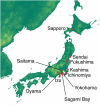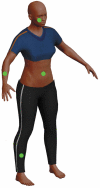Biologically effective solar ultraviolet exposures and the potential skin cancer risk for individual gold medalists of the 2020 Tokyo Summer Olympic Games
- PMID: 32166106
- PMCID: PMC7053926
- DOI: 10.1080/23328940.2019.1581427
Biologically effective solar ultraviolet exposures and the potential skin cancer risk for individual gold medalists of the 2020 Tokyo Summer Olympic Games
Abstract
Personal solar ultraviolet radiation exposure models were developed for 144 Olympic events scheduled outdoors from across the 33 sport disciplines that will compete in Tokyo between 24 July and 9 August 2020. Ambient exposure models were developed from existing atmospheric parameters measured over Tokyo (35.7°N 139.7°E) and were used to weight erythemally effective solar ultraviolet exposure to gold medalists, taking into account body posture and expected protection by competitor's clothing which was assessed in comparison to respective medalists of the 2016 Rio Olympics. Individual exposure models consider the ultraviolet surface albedo (lawn, concrete, water or sand) and timing of daily events held within Olympic venues. Exposure assessments are presented, including assessments of all preliminary rounds and qualifiers. Within scheduled outdoor events, we award first place (representing the highest and most harmful UV exposure) to the women's tennis singles (1680 J/m2), second to men's golf (1530 J/m2) and third to the men's cycling road race (941 J/m2) for the highest expected erythemally effective solar ultraviolet radiation exposures of the 2020 Tokyo Games. The highest expected solar ultraviolet exposures for nations expected to win greater than three gold medals among the outdoor events were found to occur in athletes from Kenya followed closely by the United States and Hungary. Gold medalists from South Korea were found to demonstrate the highest level of sun protection due to clothing at the 2016 Rio Games, and are thus expected to receive the greatest relative reduction in erythemally effective exposure during the 2020 Tokyo Games.
Keywords: Olympics; Sport; clothing; skin cancer; ultraviolet.
© 2019 Informa UK Limited, trading as Taylor & Francis Group.
Figures





Similar articles
-
Incidence and factor analysis for the heat-related illness on the Tokyo 2020 Olympic and Paralympic Games.BMJ Open Sport Exerc Med. 2023 Apr 7;9(2):e001467. doi: 10.1136/bmjsem-2022-001467. eCollection 2023. BMJ Open Sport Exerc Med. 2023. PMID: 37051574 Free PMC article.
-
Athlete Medical Services at the Marathon and Race Walking Events During Tokyo 2020 Olympics.Front Sports Act Living. 2022 Apr 22;4:872475. doi: 10.3389/fspor.2022.872475. eCollection 2022. Front Sports Act Living. 2022. PMID: 35529419 Free PMC article.
-
Measurements of the upper body ultraviolet exposure to golfers: non-melanoma skin cancer risk, and the potential benefits of exposure to sunlight.Photodermatol Photoimmunol Photomed. 2009 Dec;25(6):317-24. doi: 10.1111/j.1600-0781.2009.00472.x. Photodermatol Photoimmunol Photomed. 2009. PMID: 19906167
-
Understanding COVID-19: A Hybrid Threat and Its Impact on Sport Mega-Events. A Focus on Japan and the Tokyo 2020 Olympic Games.Front Sports Act Living. 2022 Feb 22;4:720591. doi: 10.3389/fspor.2022.720591. eCollection 2022. Front Sports Act Living. 2022. PMID: 35274095 Free PMC article. Review.
-
Solar Ultraviolet Exposure in Individuals Who Perform Outdoor Sport Activities.Sports Med Open. 2020 Sep 3;6(1):42. doi: 10.1186/s40798-020-00272-9. Sports Med Open. 2020. PMID: 32880767 Free PMC article. Review.
Cited by
-
Tokyo-2020ne, Temperature and time for reflection.Temperature (Austin). 2020 Aug 6;7(2):109-110. doi: 10.1080/23328940.2020.1784684. eCollection 2020. Temperature (Austin). 2020. PMID: 33015238 Free PMC article. No abstract available.
-
Hand and torso pre-cooling does not enhance subsequent high-intensity cycling or cognitive performance in heat.Temperature (Austin). 2019 Jun 25;7(2):165-177. doi: 10.1080/23328940.2019.1631731. Temperature (Austin). 2019. PMID: 33015244 Free PMC article.
-
A multi-scalar climatological analysis in preparation for extreme heat at the Tokyo 2020 Olympic and Paralympic Games.Temperature (Austin). 2020 Mar 19;7(2):191-214. doi: 10.1080/23328940.2020.1737479. eCollection 2020. Temperature (Austin). 2020. PMID: 33015246 Free PMC article.
-
Skin cancer biology and barriers to treatment: Recent applications of polymeric micro/nanostructures.J Adv Res. 2021 Jun 16;36:223-247. doi: 10.1016/j.jare.2021.06.014. eCollection 2022 Feb. J Adv Res. 2021. PMID: 35127174 Free PMC article. Review.
-
Golf participants in Australia have a higher lifetime prevalence of skin cancer compared with the general population.BMJ Open Sport Exerc Med. 2023 Jul 20;9(3):e001597. doi: 10.1136/bmjsem-2023-001597. eCollection 2023. BMJ Open Sport Exerc Med. 2023. PMID: 37485003 Free PMC article.
References
-
- Mulcahy KV. Public culture, cultural identity, cultural policy: comparative perspectives. New York: Palgrave Macmillian; 2017. Chapter 3, Patronizing mega-events to globalize identity: the Olympic opening ceremony as a cultural policy; p. 65–92.
-
- Owens J. Television sports production. New York: Routledge; 2016.
-
- Tang T, Cooper R. The most social games: predictors of social media uses during the 2016 Rio Olympics. Commun Sport. 2018;6:308–330.
-
- Gambarato RR, Alzamora GC, Tarcia LPT. 2016 Rio Summer Olympics and the transmedia journalism of planned events. In: Gambarato RR, Alzamora GC, editors. Exploring transmedia journalism in the digital age. Hershey (USA): IGI Global; 2018; p. 126–146.
-
- Hutchins B, Sanderson J. The primacy of sports television: Olympic media, social networking services, and multi-screen viewing during the Rio 2016 Games. Media Int Aust. 2017;164:32–43.
LinkOut - more resources
Full Text Sources
Miscellaneous
